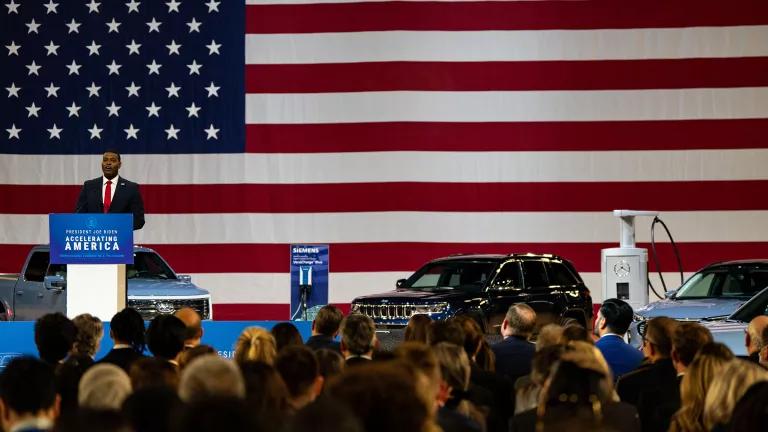
Northeast states are piecing together robust electric vehicle plans to create a new clean transportation map. But right now, that map has a Pennsylvania-sized hole.
New Jersey just passed major electric vehicle legislation designed to make it the East Coast leader by creating a robust rebate program for electric vehicle purchases and increasing charging station infrastructure. The same day, the New York State Department of Public Service called for a major $582 million investment to build out charging station infrastructure throughout the state.
Both states have set lofty goals for electric vehicle penetration: New Jersey, 330,000 and New York, 850,000 both by 2025. Pennsylvania, however, is sitting idly by while its neighboring states are leaping ahead.
The good news: there’s a bill in Harrisburg that, if passed, would make a big difference and get Pennsylvania on the map of electric vehicle leadership.
Pennsylvania currently has charging stations at 550 locations statewide. This may sound like a lot, but thousands more are needed to support widespread electric vehicle adoption across the state. To put it into perspective, if just 8 percent of the state’s cars and trucks run on electric power, Pennsylvania would need more than 8,000 public charging stations.
SB596: An EV Roadmap for PA
The Pennsylvania legislation is slowly working its way through the legislative process. The bill seeks to address this problem by directing electric utilities to develop charging stations networks—that include both utility owned stations as well as third-party owned stations—so that electric vehicle drivers in Pennsylvania won’t run out of juice.
This model of utility investments is not unheard of: over 30 other utilities around the country were granted approval to own charging stations. Joint utility and third-party incentive programs allow for the utilities to install charging stations in communities potentially underserved by the private charging industry—such as in disadvantaged (e.g. environmental justice and low-and-moderate income communities) and less frequently traveled locations—while also fostering a competitive market.
The bill also aims to electrify big vehicles, including transit buses, delivery trucks and tractor trailers – increasing clean transportation options for people and products throughout Pennsylvania.
Since electric vehicles have lower fueling and maintenance costs, they help Pennsylvanians keep more money in their pockets. What’s more, electric vehicles are rapidly coming down in price, and with over 40 models available for drivers to choose from (plus an emerging used car market). With more options and longer ranges, more and more Pennsylvanians are clamoring for electric vehicles. This bill would provide the crucial infrastructure to support that demand.
Additionally, developing plans to stabilize the grid and shift charging to off-peak hours, as this bill would, would save all Pennsylvanians money by putting downward pressure on rates.
Equally crucial, this shift to electric vehicles would do a lot to clean up the air we breathe, which would benefit all Pennsylvanians, including the 236,000 children and 1 million adults that suffer from asthma in the Keystone State. Getting gas-guzzlers off the road and switching to electric vehicles reduces smog and ground level ozone, helping to prevent respiratory illnesses and premature death.
By building modern public transit with clean technology, Pennsylvania could lead the region. The Keystone State is already home to several vital businesses that support the electric vehicle industry. Some manufacture components for charging stations. Others produce vehicle parts. These business opportunities would only grow after the legislature moved forward in supporting the electric vehicle market.
In addition to the health, societal and economic benefits, electric vehicles also have climate benefits as well. On-road vehicles currently make up nearly a third of Pennsylvania’s climate pollution. A thriving electric vehicle market would help Pennsylvania achieve its goal to reduce greenhouse gas emissions 26 percent by 2025 and 80 percent by 2050. Electric vehicles don’t emit harmful tailpipe emissions and cut climate pollution by over 7,000 pounds of carbon dioxide ever year per vehicle. As more school buses and delivery trucks also convert to electric power, these benefits will continue to grow.
While Pennsylvania does have an electric vehicle roadmap and a rebate program for the purchase of electric vehicles, without the infrastructure to support these vehicles, the market won’t be able to blossom and grow quickly. Other states on the East Coast grasp the need for policies and programs that support the electric vehicle market. Pennsylvania now can capitalize on the opportunity to join its neighbors by signing the electric vehicle legislation into law. If it doesn’t, it stands to lose the all the benefits that its neighbors are poised to realize.




